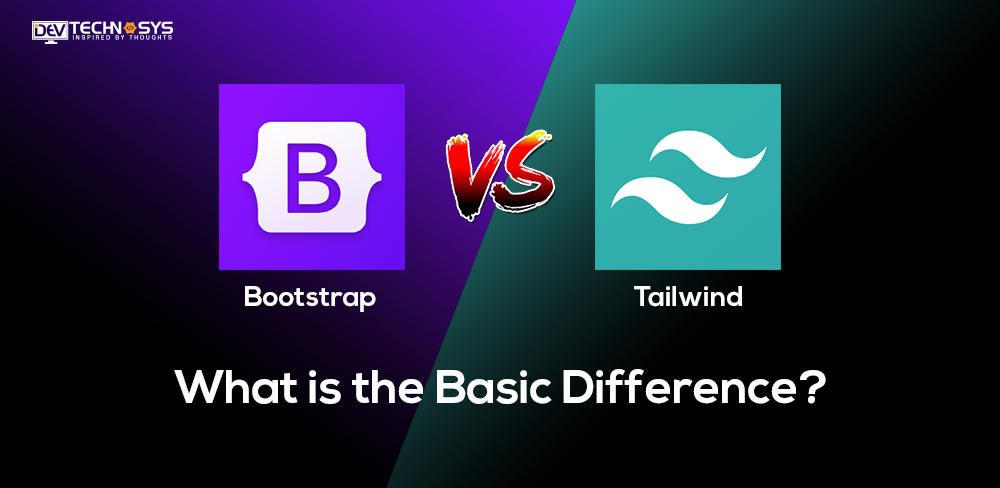Are you looking for the difference between Bootstrap vs Tailwind? Then this comprehensive guide will help you.
For a website to be top-notch, it must have a fluid design with responsive layouts and an interactive style. The CSS must be implemented in such a fashion that it eliminates all chances of confusion at the next development stage and minimizes the amount of effort needed as the application grows.
For a great responsive UI, you can choose from popular UI kits like Bootstrap vs Tailwind is also a good option. Sometimes media queries will work. But what if a customized UI is desired? Was this the main reason for the increased popularity of Tailwind CSS?
Let’s understand.
What is Bootstrap?
Bootstrap was first made available by Mark Otto and Jacob Thornton on August 19, 2011, and it is still the most widely used CSS framework in online business. What is interesting is that the original name of this framework was Twitter Blueprint, which was mainly used as an internal tool for Twitter’s developer team.
The framework includes hundreds of components that can quickly get you started building a website, such as dropdowns, modals, navigation bars, cards, buttons, and much more.
The recommended way of working with it is to modify and compile the Sass files, which enables you to use variables and mixins (functions) to generate the OOCSS classes for buttons, cards, and so on.
You’ll also probably want to include the JavaScript file, which enables the interactivity of these components using data attributes or their API via events and objects.
What is Tailwind?
Adam Wathan and Steve Schoger, who are currently employed by the Tailwind Labs business, first published the open-source CSS framework known as Tailwind CSS on November 1, 2017. In contrast to the traditional OOCSS frameworks like Bootstrap or Bulma, it is the fastest-growing framework available.
Based on a utility-first paradigm, it provides a collection of predefined utility classes for padding, text colors, margins, font sizes, and more to assist you in creating these components instead of requiring you to create bespoke classes to design buttons or cards.
It’s very easy to style elements directly from your HTML, and there’s no more need to remember and build class name constructs that have to be relearned every time somebody joins your team.
Bootstrap vs Tailwind–Advantages
In this section, we will discuss the advantages of Bootstrap vs Tailwind. So let’s have a look:
Advantages of Bootstrap
- Easy to initiate
For someone who has no experience in web development, coding is a daunting task. Bootstrap is the best tool for web development because it simplifies coding. Bootstrap takes care of everything. Bootstrap allows anyone to create an appealing landing page, even if they have no extensive knowledge of code.
Only a moderate level of CSS and HTML knowledge is required. Bootstrap can be easily integrated into existing websites and those that are newer. You can easily integrate Bootstrap into your existing CSS.
- Responsiveness
Statistics highlight over 6.4 billion smartphone users around the world. This study suggests that smartphone penetration is over 80 percent. The numbers don’t stop there; they are actually increasing rapidly. Making a website that is mobile responsive is simple with Bootstrap. Bootstrap has a fluid grid that adapts to the screen resolution.
- Highly Customizable
Bootstrap comes with a variety of templates. If you don’t like them, you can customize the CSS file. If you don’t have the time to create everything from scratch, the customization can be blended with the existing code. This will enhance functionality. This can all be done under the customization page.
- User-centric
When creating landing pages, you should always design them from the user’s perspective. Only when a landing is engaging will it be appealing to the audience. You may create landing pages with Bootstrap that are adapted to the requirements of your audience.
It makes suggestions about elements such as photos and Call-to-Actions (CTA), which are best suited for your audience. It also helps to make easy edits to landing page elements to reach out to more audiences.
Advantages of Tailwind
- It is Highly Customizable:
Tailwind CSS has a high level of customization. It comes with a standard configuration, but it’s easy to change it by using tailwind.config.js. The configuration file allows for easy customizations of color palettes and styling. It also allows you to customize themes, spacing, colors, etc. Tailwind is a combination of the best utilities to facilitate project management and maximize CSAT.
- It Has Common Utility Patterns:
There are frequent utility patterns in Tailwind CSS. Save yourself the trouble of class naming. Common utility patterns are a great way to solve a variety of problems, such as naming classes, organizing them, and cascading them. It is simpler to construct custom components thanks to utility classes. Tailwind CSS does not require you to code hard. Use the theme() to extract values directly from the configuration files.
- It Can Be Optimized Using PurgeCSS:
Tailwind CSS has the advantage that you can perform optimizations using PurgeCSS. PurgeCSS reduces the file size by removing classes that are not used. PurgeCSS can be easily set up in conjunction with Tailwind CSS. It is highly recommended that you do this before deploying your site. The CSS file size increases as the project size grows. Tailwind prevents this from happening. As long as the project is active, the use of a standard set of classes will keep the file size down.
- It Enables Building Complex Responsive Layouts Freely:
The Tailwind CSS Framework’s default strategy is mobile-first. Complex responsive layouts are simpler to design, thanks to utility classes. Utility classes are conditionally applicable to a wide range of breakpoints, which makes it easy to build complex responsive layouts.
- You can easily interact with the community:
Have a problem that you cannot solve? Tailwind CSS can be a great solution. Join this community to receive comprehensive support from other users whenever you need it. Get immediate answers to all of your CSS-related questions and easily build outstanding applications and websites. Issues may be quickly fixed using Tailwind CSS.
Bootstrap vs Tailwind–Disadvantages
Now that you know the benefits of Bootstrap vs Tailwind, let’s now also see their disadvantages. So let’s begin.
Disadvantages of Bootstrap
- Bootstrap websites all look the same.
Bootstrap is a tool created by Twitter to work faster on a standard interface. It’s not aligned completely with the concepts of web design. This has the main disadvantage that all Bootstrap-based sites will look very similar. It’s possible to override or modify style sheets manually, but that defeats the whole purpose of using Bootstrap. Even if you manage to do this, all sites built using Bootstrap will still be recognizable.
- There is a learning curve.
Bootstrap is easy to use, but you’ll still need to put in some effort. Bootstrap’s CSS classes are available, but you will also need to understand how Bootstrap components use them. It will also take some time for you to get familiar with the grid system. Bootstrap documentation is excellent and will help you learn the basics. Once you are comfortable with it, you won’t have to spend much time adapting the newer code versions.
- Heavyweight
Bootstrap makes it easy to create a responsive site, but the end result can be heavy on the user in terms of battery drain and slower loading times. Bootstrap files might be big, which can slow down your website. Manual file deletion is a possibility. But doing so violates the entire point of utilizing Bootstrap.
Disadvantages of Tailwind
- It is Necessary to Build a Step
While the original Tailwind stylesheet was something you could just drag and drop, more recent versions require that you run a build to generate CSS. It adds an extra step to the creation of a website. This can be a complex process for a developer unfamiliar with the front-end development processes. This process is easy to integrate into many of the front-end frameworks that already use build processes.
- Learn How to Set up and Use the System
Tailwind is a great tool to use if you know CSS. Install it, configure it (if you don’t want to accept the defaults), then learn how the different parts of Tailwind function. The great documentation provided by Tailwind makes it simple to get the details you want. There are also many tutorials and good examples. Usually, a couple of days of practice and study is all you need to become proficient.
- Larger HTML Sizes
Because the utility-first approach frequently necessitates adding several classes to your HTML, the download size could grow. This is because this extra data, which is repetitive, tends to be compressed very easily. The net effect on the user experience may not be that significant.
The Algolia employee Sarah Dayan addressed this issue in her presentation titled “In Defence of Utility First CSS.” She demonstrated how utility-first differed from component-first by using an existing page. The uncompressed size of the utility-first version was 20% greater. Once compressed. However, the difference was just a few percentages.
- Tailwind is Not a One-Size-Fits-all Solution
Tailwind is constantly improving, but there are still some CSS properties and advanced methods that it cannot handle. You may need to use Tailwind in conjunction with some custom classes or add some inline styling to accomplish certain tasks. Is it a bad thing? Tailwind may not be the panacea to all problems, but this isn’t necessarily a bad thing.
Bootstrap vs Tailwind – Similarities
Let’s first look at the similarities. The frameworks are designed to abstract CSS code from your workflow. This allows you to focus on the UI and not have to worry about CSS.
This is because all you need to do is use class names within your HTML markup.
Frameworks will then handle the CSS behind closed doors. While it is true that the use of many classes in HTML markup can make the markup look cluttered, the frameworks are a great way to simplify the process and build UIs faster.
Both tools have existed for a long time and are used by successful and high-profile companies. Their use in large deployments at scale is proof that both can be applied. Bootstrap’s use is reported by StackShare to be at over 40k organizations, including Spotify and Udemy Twitter. Tailwind is the CSS used by Hashnode.
Bootstrap vs Tailwind-Key Difference
| Bootstrap | Tailwind CSS |
| It is one of the most well-liked HTML, CSS, and JS frameworks for building apps that are mobile-first and responsive. | This is the most well-liked CSS framework for developing unique user interfaces. |
| It provides pre-made layouts and themes. | It provides distinctive utility-first courses |
| Because Bootstrap has built-in website templates, applications made with it tend to be the same | Tailwind CSS allows for the creation of distinctive and adaptable applications and web pages. |
| An earlier framework noted for its responsiveness and effectiveness is called Bootstrap. It helps developers save a tonne of time. | A more recent framework, Tailwind CSS, is continually developing and expanding. |
| It requires a large file size | It requires a small file size |
| Twitter, LinkedIn, Spotify, and StackShare are well-known firms that use Bootstrap. | Popular businesses that use Tailwind CSS include MAKE IT, Superchat, Hashnode, and Livestorm. |
Bootstrap vs Tailwind–Detailed Comparison
Bootstrap vs Tailwind are both popular front-end frameworks used for building responsive and visually appealing websites. Despite certain similarities, there are major differences in their approaches, degrees of customization, and usability. Here is a thorough contrast between Bootstrap and Tailwind:
1. Approach:
- Bootstrap: Bootstrap is a component-based framework that provides a set of pre-designed UI components. It follows a more opinionated approach, meaning it comes with predefined styles and structures that you can use out of the box.
- Tailwind: The utility-first architecture Tailwind offers a wide range of utility classes. It takes a more low-level approach, allowing you to build custom designs by combining these utility classes.
2. Customization:
- Bootstrap: Bootstrap offers customization options, but they are somewhat limited. While you can modify the default styles by overriding CSS classes or using Sass variables, making significant changes may require more effort.
- Tailwind: Tailwind is highly customizable and allows you to create unique designs easily. It provides an extensive set of utility classes that can be composed together to create custom styles. Tailwind’s configuration file allows you to customize colors, breakpoints, spacing, and more.
3. File Size:
- Bootstrap: Due to the numerous pre-designed components and styles it provides, Bootstrap, by default, has a bigger download size. The overall file size of your project may rise if you employ the complete framework.
- Tailwind: Tailwind has a smaller file size as it focuses on utility classes rather than predefined components. However, when using Tailwind, the HTML file size might increase due to the use of multiple utility classes.
4. Learning Curve:
- Bootstrap: Bootstrap has a moderate learning curve. Its extensive documentation, well-defined components, and consistent naming conventions make it relatively easy to grasp for beginners.
- Tailwind: Tailwind has a steeper learning curve compared to Bootstrap because it requires understanding and combining various utility classes effectively. Learning about the utility classes and their use may take some time.
5. Flexibility:
- Bootstrap: Bootstrap offers a wide range of pre-built components and layouts, making it ideal for quickly prototyping or building projects with standard UI patterns. It might not be as adaptable when coming up with extremely customized designs.
- Tailwind: Tailwind’s utility-first approach provides flexibility and allows for more creativity in terms of design. You can easily create custom designs by combining utility classes, giving you more control over the visual aspects of your project.
6. Community and Ecosystem:
- Bootstrap: Bootstrap has a large and active community with extensive documentation, resources, and a wide range of third-party themes and plugins available. It has a more established environment and has been around longer.
- Tailwind: In recent years, Tailwind has significantly increased in popularity, and its user base is expanding. While its ecosystem is not as mature as Bootstrap’s, it has a decent collection of themes, plugins, and integrations available.
Bootstrap vs Tailwind-Which one is Better?
All of the above is very informative but leaves room for interpretation as to which option is the best Bootstrap vs Tailwind. This question is subject to interpretation by each individual. Each option has pros and cons.
There are many ways to determine which one is the best for you. You can identify pros and cons to determine which will best suit your needs. Both have their merits, especially when it comes to quickly developing user interfaces.
Tailwind is a relatively new tool, but its popularity is increasing rapidly. It has gained a lot of support from the developer community. Only you and your team can decide what approach is best for your needs.


















